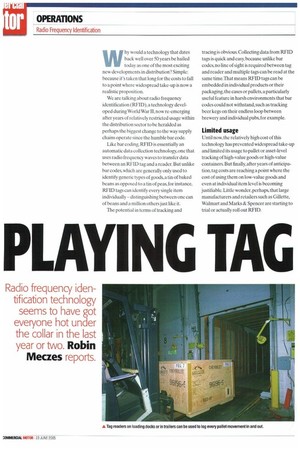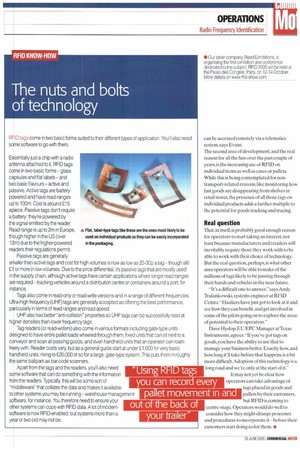PLAY NG TAG
Page 52

Page 53

Page 54

Page 55

If you've noticed an error in this article please click here to report it so we can fix it.
Radio frequency iden tification technology seems to have got everyone hot under the collar in the last year or two. Robin
Meaes reports. Wby would a technology that dates back well over 50 years be hailed today as one of the most exciting new developments in distribution? Simple: because it's taken that long for the costs to fall to a point where widespread take-up is now a realistic proposition.
We are talking about radio frequency identification (RFID), a technology developed during World War!!, now re-emerging after years of relatively restricted usage within the distribution sector to be heralded as perhaps the biggest change to the way supply chains operate since the humble bar code.
Like bar coding, RFD is essentially an automatic data collection technology, one that uses radio frequency waves to transfer data between an RFID tag and a reader. But unlike bar codes, which are generally only used to identify generic types of goods, a tin of baked beans as opposed to a tin of peas, for instance, RFID tags can identify every single item individually — distinguishing between one can of beans and a million others just like it.
The potential in terms of tracking and tracing is obvious. Collecting data from RFID tags is quick and easy, because unlike bar codes, no line of sight is required between tag and reader and multiple tags can be read at the same time.That means RFID tags can be embedded in individual products or their packaging, the cases or pallets, a particularly useful feature in harsh environments that bar codes could not withstand, such as tracking beer kegs on their endless loop between brewery and individual pubs, for example.
Limited usage
Until now, the relatively high cost of this technology has prevented widespread take-up and limited its usage to pallet or asset-level tracking of high-value goods or high-value containers. But finally, after years of anticipation, tag costs are reaching a point where the cost of using them on low-value goods and even at individual item level is becoming justifiable. Little wonder.perhaps.that large manufacturers and retailers such as Gillette, Wahnart and Marks & Spencer are starting to trial or actually roll out RFID, And a drive by manufacturers and retailers today will turn into a prerequisite for all those that work with them tomorrow. But apart from the fact that the goods you carry may soon all be RFID tagged by those you work for, what are the opportunities for goods vehicle operators in this new, RFID-enabled world?
They are actually many and varied.At vehicle level, for instance. RFID tags are already being used by firms like FedEx in the US to replace vehicle keys. Drivers wear a wristband containing a tag that a reader in the truck recognises as they approach, avoiding the need for a driver to juggle armloads of packages while searching for keys, and doing away with the cost of re-keying if keys are lost. Such systems can also be used to ensure only authorised drivers start the engine.
Individual trucks
Other firms have also begun using RFID tags on board trucks and trailers to log them automatically in and out of depots—usually via readers placed at the site gates. Similarly, RFID tags on board vehicles can be used in conjunction with readers on loading docks to ensure the right vehicle is in the right place at the right time, and the right goods are being loaded or unloaded. Some firms even use RFID to track individual trucks or trailers within individual depots, using a network of readers at strategic points around the site.
In more general terms, RFID is also used for security applications such as access control — tags embedded in badges, for instance, to grant or deny particular people access to particular areas. It's a useful technology for asset tracking — plant an RFID tag in a valuable laptop with a reader on every door or even on the site entrance, for instance, and you'll know if someone tries walking out with it.
These are all well-established applications for RFID, but there are two new areas where it is really starting to come into its own.
The first is the integration of RFID with telematics systems,because while telematics systems on their own may let you track a vehicle or trailer, they don't let you track individual pallets onboard. Using RFID tags with an onboard reader in the load space, however, you can record every pallet movement in and out of your trailer, Combine that with the real-time location monitoring capability of modern telematics systems and you've got the ability to monitor individual pallets or cases at every stage of distribution.
"At the moment, you can only get confirmation of goods at certain control points in the chain — like a customer's loading dock. And even then, you need what can be large and expensive RFID antennas at the dock to do that automatically," saysTun Evans, sales and marketing director of trailer telematics specialist,TrakM8."But using RFID as part of the onboard vehicle system, you can keep your own internal records of goods arriving on a vehicle and leaving and you can use the telematics system to stamp that with the location and time and communicate that back to you in real time."
RFID can also be used to monitor which tractive units and trailer are coupled together at various points and, again, that information can be accessed remotely via a telematics system, says Evans.
The second area of development, and the real reason for all the fuss over the past couple of years, is the increasing use of RFID on individual items as well as cases or pallets. While this is being contemplated for nontransport-related reasons, like monitoring how fast goods are disappearing from shelves in retail stores,the presence of all those tags on individual products adds a further multiple to the potential for goods tracking and tracing.
Real question
That, in itself, is probably good enough reason for operators to start taking an interest, not least because manufacturers and retailers will inevitably require those they work with to be able to work with their choice of technology. But the real question, perhaps, is what other uses operators will be able to make of the millions of tags likely to be passing through their hands and vehicles in the near future.
"It's a difficult one to answer," says Andy Trafankowski, systems engineer at RFID Centre. "Hauliers have just got to look at it and see how they can benefit, and get involved in some of the pilots going on to explore the area of potential to their operation."
Dave Hyslop, EU EPC Manager at Texas Instruments, agrees."If you've got tags on goods, you have the ability to use that to manage your business better. Exactly how, and how long it'll take before that happens, is a bit more difficult. Adoption of this technology is a long road and we're only at the start of it" It may not yet be clear how operators can take advantage of tags placed in goods and pallets by their customers, but RFID is coming to centre-stage. Operators would do well to consider how they might change processes and procedures to incorporate it —before their customers start doing so for them. •












































































































































































































